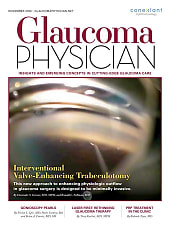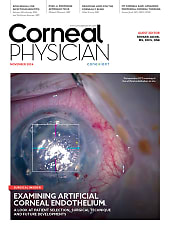The Gore-Tex suture is, as described by its manufacturer (Gore Medical), a “microporous, monofilament suture of flexible biomaterial for excellent handling, reduced hole-leakage, and minimal irritation in soft tissue approximation.”1 The popularity of the Gore-Tex suture with ophthalmologists has increased in the last 10 years, with several different ab externo intraocular lens fixation approaches described previously.2-5
In this article, we will discuss scleral fixation of the enVista MX 60E and Akreos AO60 (Bausch + Lomb).
PREOPERATIVE ASSESSMENT AND COUNSELING
Examination should include carefully searching for prior sclero-corneal incisions and areas of conjunctival scarring and tissue atrophy. Patients with tube shunts, multiple previous conjunctival violating procedures, or rheumatologic conditions previously affecting the sclera and conjunctiva may not be good candidates.
Patients should understand that so-called “premium lens implants” are still not available for correction of astigmatism or intermediate and near vision with these techniques. There is a higher likelihood that these patients will require postoperative spectacle vision correction. Also, they must understand the postoperative healing time course is longer, and that there will be significantly more irritation and redness than with typical cataract surgery.
SURGICAL TECHNIQUE PEARLS
External marking is an important first step with both the enVista and the Akreos. There are many commercially available external marking devices to ensure you have reference marks on the limbus 180° apart. A partial peritomy should be created large enough to easily visualize sclerotomy placement, and cautery performed to the sclera in the areas where sclerotomies will be placed is suggested.
Sclerotomy Placement
The surgeon may choose to create four separate sclerotomies for the Gore-Tex lens fixation in addition to the standard three trocar sclerotomies, or incorporate two trocar sclerotomies as fixation sclerotomies. Incorporating the trocar sclerotomies is an easier technique and makes it easier to bury the Gore-Tex suture knots, while creating four separate sclerotomies allows continued access for vitrectomy and endolaser after the lens has been fixated.
Marked calipers or trocar handles aid in placing sclerotomies the correct distance from the limbus. Accurate marking from the limbus is essential to avoid tilt, decentration, iris chafing, and refractive surprises. Effective lens power changes with lens placement anteriorly or posteriorly, and we have found that typical “in the bag” IOL calculations can be used with fixation targeted at 2.5 mm to 3 mm posterior to the limbus.
For the Akreos lens, two sclerotomies are created either 2.5 mm or 3 mm from the limbus and separated tangentially approximately 4 mm to 5 mm apart followed by identical placement of two sclerotomies 180° apart. For example, if the 180° marks are at 3 and 9 o’clock, the four sclerotomies may end up at 2, 4, 8, and 10 o’clock. The same placement can also be used when fixating the enVista lens.
Alternatively, the enVista can also be fixated by creating radial sclerotomies at 2 mm and 4 mm from the limbus 180° apart. The trocar blade entry should be parallel to the iris and straight, so as to facilitate the forceps entry and suture passage and also creates a more watertight wound. A marker can be used on each sclerotomy site after creation, as they may become difficult to find after several minutes. Creating a partial thickness scleral incision or groove between sclerotomies can help avoid an elevated suture postoperatively.
Corneal Incision
The corneal incision should be created large enough to accommodate a manually folded lens (approximately 3 mm keratome) or matched to appropriate IOL insertion cartridges. The use of viscoelastic to protect the endothelium and maintain anterior chamber stability is recommended.
Suture Passage
Intraocular micro forceps are recommended for passage and retrieval of the Gore-Tex size CV-8 suture. Disposable versions are especially useful, as they can be manually bent to aid in reaching posterior to iris and then toward the central pupillary axis.
The Akreos lens has four eyelets, and two have visible notches for orientation. When the lens is correctly oriented, the two notched eyelets will be aligned to each other like a forward slash on a keyboard. A single Gore-Tex CV-8 suture is cut in half and threaded through the eyelets on each side.
When fixating an enVista lens using tangential sclerotomies, extra care must be taken to ensure the suture is passed correctly because there is only one eyelet, and incorrect orientation of the sutures can cause severe lens tilt. The sutures must be passed through the eyelets so that the suture ends lay across the haptics the same way on each side. For example, if the suture lays across the haptics on one side and under the haptics on the opposite side, the lens will tilt.
Suture endings can be marked with a marking pen to correctly identify which suture ending is intended for which sclerotomy. For example, the inferior suture ends may be marked corresponding to the inferior sclerotomy on each side with the tangential Akreos or enVista technique, or the suture ends corresponding to the posterior sclerotomy may be marked for the radial enVista technique. The handshake technique is then used to pass the corresponding suture end through the corneal incision with one forcep, and then retrieved and removed through the corresponding sclerotomy with an additional forcep.
All four suture ends can be passed out their corresponding sclerotomies prior to IOL insertion. Alternatively, the surgeon may pass one side only and then insert the IOL. Once inserted, the opposite eyelets can be directly visualized and orientation confirmed prior to retrieval and externalization through corresponding sclerotomies. Occasionally, the IOL may need to be pushed further posterior in the mid-vitreous to help visualize the correct suture orientation at the eyelets on both sides. Correct suture orientation must be confirmed prior to knot tying.

Knot Tying
Now that the IOL is inserted, well-centered, and the correct suture orientation has been verified, the Gore-Tex suture can be tied. Care must be taken during knot tying to maintain IOL centration and avoid excessive force on the IOL eyelets. A 3-1-1 technique can be used with light force applied on the knot at the “3 stage,” and then more force applied to “lock” the suture down at the “1-1” stages. The knots are then trimmed and rotated internally. With the radial enVista technique care, must be taken to only rotate the sutures posteriorly, as anterior rotation can result in the suture knot chafing the back of the iris.
Closure
Sclerotomy sites may be left for self-sealing, or sutured closed with the surgeon’s preference of absorbable suture. Care must be taken to avoid cutting the Gore-Tex suture while passing needles for sclerotomy closure. Fluorescein may aid in visualizing sclerotomy leakage. Peritomy should be closed, ensuring good tenon and conjunctival closure of sclerotomies and Gore-Tex sutures.
PITFALLS
There are currently no intraocular lenses designed and approved for scleral fixation as described. The Akreos lens is a hydrophilic acrylic lens and is reportedly subject to opacification with intraocular air, gas, or silicone oil.6 The Akreos lens can be over-tightened and induce lenticular astigmatism and the enVista eyelets can be broken.7 There is an inherent risk of decentration and/or lens tilt with either of the intraocular lenses. Gore-Tex erosion has been described, and partial scleral burying may be helpful.

CONCLUSION
Scleral fixation of enVista or Akreos IOLs with the Gore-Tex suture can be used in combination with vitrectomy in appropriate patients where capsular bag or sulcus placement of a lens isn’t possible. We have found good stability and predictable postoperative outcomes in our hands, however, additional long-term data is needed. NRP
REFERENCES:
- Gore Medical website. Gore-Tex Suture. Available at: https://www.goremedical.com/products/suture . Last accessed Mar. 16, 2021.
- Khan MA, Gerstenblith AT, Dollin ML, et al. Scleral fixation of posterior chamber intraocular lenses using Gore-Tex suture with concurrent 23-gauge pars plana vitrectomy. Retina. 2014;34:1477-1480.
- Khan MA, Gupta OP, Smith RG, et al. Scleral-fixation of intraocular lenses using Gore-Tex suture: clinical outcomes and safety profile. Br J Ophthalmol. 2016;100:638–643.
- Khan MA, Rahimy E, Gupta OP, Hsu J. Combined 27-gauge pars plana vitrectomy and scleral fixation of an Akreos AO60 intraocular lens using Gore-Tex suture. Retina. 2016;36:1602-1604.
- Wang W, Syed R, Hadayer A, et al. Twenty-seven-gauge vitrectomy-assisted four-point scleral fixation of intraocular lens in the absence of capsular support. Retina. 2016;36: 1605-1608.
- Cao D, Zhang H, Yang C, et al. Akreos Adapt AO intraocular lens opacification after vitrectomy in a diabetic patient: a case report and review of the literature. BMC Ophthalmol. 2016;16:82.
- Lippincott JK, Collins MM, Tieu BC. Gore-Tex scleral-sutured enVista IOL dislocation: three cases and an assessment of eyelet tensile strength, fracture characteristics, and risk factors. Retin Cases Brief Rep. 2020; Nov 18. [Ahead of print]








